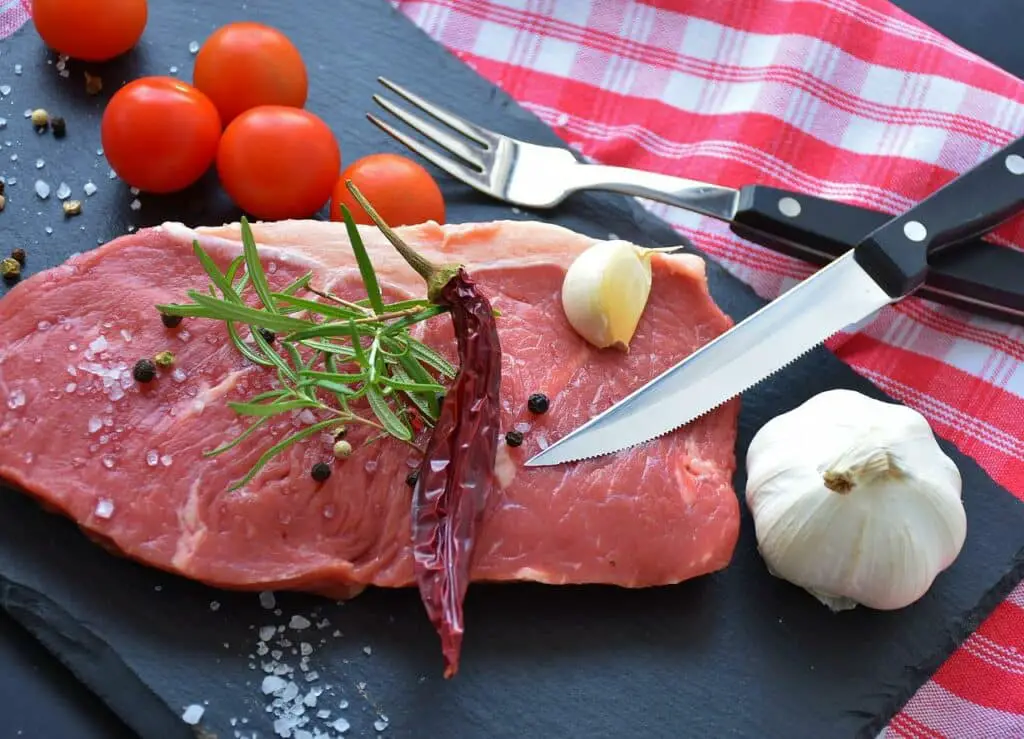Everything’s set for the party you’re hosting.
You’re assigned to prep the beef while waiting for the chef to arrive.
Your dog speeds up and down, wagging the tail and drooling.
This leaves you in a quagmire.
Should you share some?
Can dogs have raw beef?
Yes, they can, but it should be in moderation as there are risks involved.
Before you share the raw beef with your dog, there are considerations to be made, such as verifying the type of beef, its health and how much you should share.
Have you ever imagined what would happen If the pet dogs we own were sent back to the wild?
Would they be carnivores or omnivores?
What’s your opinion on that?
This article will focus on the carnivorous side and explore whether dogs can have raw beef.
It’ll also explore the benefits and risks of sharing.

Benefits of Sharing Raw Beef with Your Dog
Sharing meals out of the normal will excite the buddy, and raw beef is no exception, but what benefits does the dog get?
- Nutritional Value
Raw beef contains different nutrients that are beneficial to the dog.
The beef contains:
- Proteins
- Vitamin B12
- Fat
- Carbohydrates
All these nutrients play a role in the well-being of a dog.
For instance, proteins should be the highest nutrient in a dog’s meal.
This is because proteins boost a dog’s overall performance and help it recover in the event of an injury.
If you want to boost the dog’s muscle formation and improve its hair and skin texture, then you should share some raw beef with the dog.
Vitamin B12 helps a dog’s cell formation and is critical in boosting its nervous system and brain functioning.
Fats and carbohydrates increase a dog’s energy levels, giving it stability and balance.
- Improves Dog’s Skin and Coat Health
Raw beef is rich in fatty acids, crucial in hydrating the dog’s skin and coat, giving it a shiny appearance.
The presence of Omega 3 and 6 in raw beef helps boosts the dog’s skin texture.
Well-hydrated skin and coat make it easy to maintain and groom, allowing you to enjoy your pet time with the dog.
- Improves Dog’s Dental Formula
If you subject your canine buddy to raw beef, especially one you have not cut to size, it will cut and disseminate the meat using the teeth.
Munching on the beef and tearing apart bones is similar to exercising, as the dental formula will strengthen.
- Improves the Digestive System
Dogs digest raw beef fast.
A dog’s metabolic system is highly activated when handling raw beef.
If you were to compare how fast the raw beef is digested with others such as kibble, you would notice a big difference in the time it takes.
Kibble takes approximately 9 hours, while beef would only need 2 hours to be fully processed.

Potential Risks of Feeding Raw Beef to Your Dog
Like everything with benefits, some potential risks of feeding your dog raw meat exist.
The risks include:
- Bacteria Infections
The main reason humans have to ensure that beef is properly cooked before we consume it is the need to eliminate the common bacteria in beef.
Dogs may not be as adversely affected by the bacteria as we do, but they also suffer from it if consumed in large quantities.
One of the common bacteria found in beef is Salmonella.
It poses a danger to the dogs’ health and may bring about these complications:
- Abdominal upsets
- Vomiting
- Diarrhea
- Loss of appetite
- Fever
- Lethargy
Avoid feeding your dog beef consistently as these ailments adversely affect the dog, making it lose its vigor and bubbly character.
Apart from the Salmonella, which is most common and has devastating effects, other bacteria that could be present in raw beef include:
- E-coli
- Listeria
- Trichinosis
- Clostridium
All these are harmful to the dog, and once you observe the signs, contact the vet immediately for guidance and treatment.
- Allergic Reaction
Some people get surprised that a dog would be allergic to raw beef.
What they forget is that since the pets are now domesticated, their systems have adapted to new feeding patterns.
Some dogs could have an allergic reaction to the beef.
Before you share the beef, evaluate past reactions.
You should consult the vet before sharing if the dog has a record of reacting to some meals.
The dog’s intolerance of raw beef triggers the reaction, which can be quite uncomfortable.
To avoid all the challenges of an allergic reaction, you are better off without raw beef.
- Choking
Sharing raw beef with your dog could result in choking up the dog, especially when they are not used.
This is because the small bones in the raw beef and the big cuts of the meat can choke.
Sometimes the choking could get worse and land you in the ER.
To avoid such extremes, stick around to observe how well the pup can chew on the beef when you feed the dog for the first few times.
How Can I Reduce the Effects of Raw Beef on My Dog?
Effects of raw beef on your dog can vary from mild and negligible to life-threatening.
First, you need to evaluate how well the dog responds to the treat.
To reduce the effects, ensure that:
- The meat is clean and doesn’t have a foul smell, which would mean it’s low quality or spoilt.
- Before sharing, consult the vet for guidance, especially if your dog has a history of intolerance to some meals heavy on proteins.
- Remove the small bones that could be hiding within the beef. Only allow big bones that the dog won’t be tempted to chew.
- Before you share the meat, have it checked for bacteria, and ensure that you buy from a reputable dealer who stocks quality and is verified by relevant authorities.
Conclusion
There is no harm in treating your dog once in a while to favorite meals that would awaken its hunting instincts, such as raw beef.
Working with a veterinary nutritionist will aid you in a great way in avoiding the risks tied to raw beef.
In addition, you will be guided on how to do it, how much and the best time to introduce beef into your dog’s diet.
Prevention is better than cure, right?
- What Dog Breeds Have Pink Skin? - March 24, 2023
- What Are the Most Inspiring Dog Breeding Quotes? - March 20, 2023
- Can Pheromone Spray Help Improve Dog Breeding Results? - March 19, 2023








